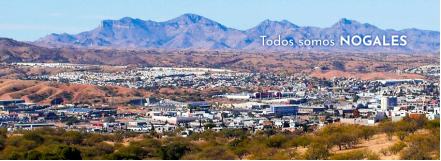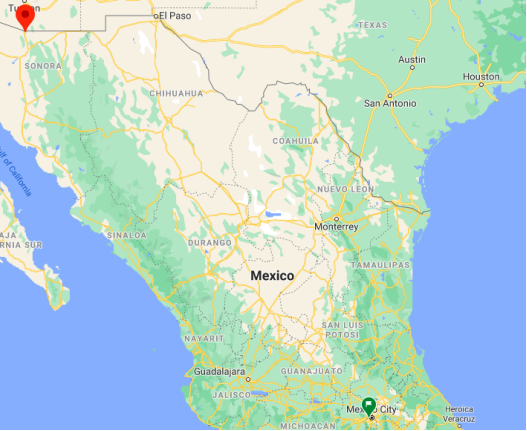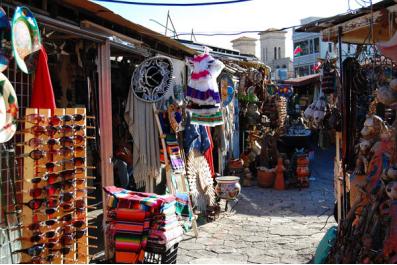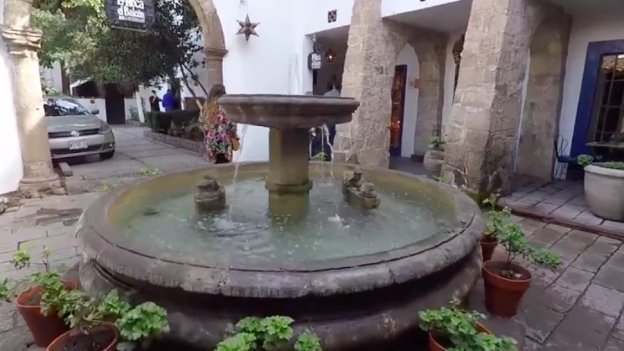Nogales, Sonora 作者: 来源: 发布时间:2021-11-19
1.Population and Area
Pop: 233,952 (city)
Area: 53,96 km2 (city)
Elev: 1214 masl

2. Natural geography
Nature and weather
Orography
The municipal territory is generally mountainous. It is made up of two hydrological currents: the one that rises to the south in the Alisos canyon that gives rise to the Magdalena River. The Magdalena River is part of the Río de la Concepción basin, which crosses the Altar desert region and the Nogales stream, which joins the Santa Cruz River, whose waters enter the United States to become part of the basin from the Gila River. The Nogales creek is formed without the help of springs and is violently runoff in the rainy seasons and dry the rest of the year. Nogales was supplied with drinking water with the groundwater of the Nogales stream, a small feeding basin, so as the population increased, it was necessary to take advantage of the water from the Santa Cruz River, which forms in the United States, penetrates to Mexican territory, joining the streams of Terrenate and Cuitaca, crossing the border on a near side of Nogales; it returns to the Arizona territory, where it joins the San Pedro, as a tributary of the Gila River.
Köppen Classification: Tropical and Subtropical Steppe Climate
This climate type occurs primarily on the periphery of the true deserts in low-latitude semiarid steppe regions. It is transitional to the tropical wet-dry climate on the equatorward side and to the mediterranean climate on its poleward margin, with a cooler, wetter winter resulting from the higher latitude and mid-latitude frontal cyclone activity. Annual precipitation totals are greater than in tropical and subtropical desert climates. Yearly variations in amount are not as extreme as in the true deserts but are nevertheless large.
The Köppen Climate Classification subtype for this climate is "BSk". (Tropical and Subtropical Steppe Climate).
The average temperature for the year in Nogales is 63.7°F (17.6°C). The warmest month, on average, is July with an average temperature of 79.5°F (26.4°C). The coolest month on average is December, with an average temperature of 49.1°F (9.5°C).
The highest recorded temperature in Nogales is 114.8°F (46°C), which was recorded in June. The lowest recorded temperature in Nogales is 14.0°F (-10°C), which was recorded in January.
The average amount of precipitation for the year in Nogales is 18.4" (467.4 mm). The month with the most precipitation on average is August with 4.7" (119.4 mm) of precipitation. The month with the least precipitation on average is May with an average of 0.2" (5.1 mm). In terms of liquid precipitation, there are an average of 48.2 days of rain, with the most rain occurring in July with 10.5 days of rain, and the least rain occurring in May with 1.1 days of rain.
In Nogales, there's an average of 4.5" of snow (0 cm). The month with the most snow is March, with 1.3" of snow (3.3 cm).
http://www.weatherbase.com/weather/weather-summary.php3?s=162167&cityname=Nogales%2C+Sonora%2C+Mexico&units=

Getting there and around
Get there
By plane – The cheapest way to get from Mexico City to Nogales is to fly and bus which costs $1300 - $3800 and takes 8h 36m.
The Nogales International Airport is a private airport for general aviation. Nearest airports for commercial flights from Mexico are in Tijuana (TIJ), Mexicali (MXL) and Hermosillo (HMO). From the U.S. side the nearest commercial airports are in Tucson (TUS) and Phoenix (PHX).
The quickest flight from Mexico City Airport to Hermosillo Airport is the direct flight which takes 2h 40m.
By car – The distance between Mexico City and Nogales is 1773 km. The road distance is 2160.9 km. It takes approximately 14h 45m to drive from Mexico City to Los Mochis.
By bus – The best way to get from Mexico City to Nogales without a car is to bus via Tlaquepaque which takes 25h 26m and costs $2000 - $3300. There are services departing from Central del Norte and arriving at Nogales via Mexico City. The journey, including transfers, takes approximately 30h 34m.
By train – There is no passenger train service in much of Mexico with the exception of the Copper Canyon Railway between Chihuahua (nearest Mexican train station) and Los Mochis through the Copper Canyon. Only commercial freight carrier cars travel the rails up into Nogales from both sides. From the U.S. side the nearest passenger train service is the Amtrak Sunset Limited (Los Angeles to New Orleans via San Antonio) and the Texas Eagle (Los Angeles to Chicago via San Antonio) passing through Tucson.
By foot – Most people simply park their cars in Nogales AZ, and walk across the border into Mexico. Typically, you won't even notice any border police on the Mexican side of the border so entrance into the city is fairly easy. Keep in mind things may change with recent headlines of gun battles at the border, so be vigilant and aware of your surroundings, but don't be paranoid about visiting the city.
If you are walking across the border from the United States into Mexico, do not forget your passport, US Passport Card, and/or your alien registration card (commonly called the "green card"). You are required to have such documentation to cross into the US side of the border. A driver's license is acceptable documentation for US Border police - only if it is issued from a US state that participates in the Enhanced Driver License program (at the time of writing this entry only driver licenses issued from: Michigan, Vermont, Washington state, and New York are acceptable). Lack of such items will delay or compromise your crossing of the border, as you'll be subjected to questioning demanding proof of US citizenship or legal residence status.
When coming back to the states on foot, consider the time of your return. The lines can be very, very long at peak hours! On a recent Saturday, the wait to return was 3 hours. Early mornings and late nights are best.
https://www.rome2rio.com/s/Mexico-City/Nogales
https://wikitravel.org/en/Nogales_(Mexico)
Rideshare – Check out Blabla Car's carpooling service for rideshare options between Mexico City and the city you are visiting. A great option if you don't have a driver's license or want to avoid public transport.
Car Rental – To explore Mexico’s provincial towns and cities—including its beach locations and the scenery and attractions near them— consider renting a car for your visit. Having your own car will give you more flexibility than using public transport options and, in some cases, offer you access to places which are otherwise difficult to visit without the use of a car.
COVID19 – International entry into Mexico from United States
Allowed for: All visitors arriving by air. Mexico land borders are closed to non-essential travel
Restricted for: There are no current restrictions.
Get around
Local Buses – Local buses and mini-buses (combis or micros) are available locally for a fraction of the cost of a taxi around town. You need to speak Spanish to be able to ask for directions or ask the driver to tell you where to get off.
Taxis – Taxis in most of Mexico’s towns and cities are not metered, so agree your price before you get in. Taxi travel is very affordable in Mexico, in comparison to the USA, Canada and Europe, and so provides a viable means of public transportation in Mexico. Your hotel can arrange taxis for you; some post their rates on a board in the lobby; taxi hotel rates are usually higher than cabs you hail off the street. If you speak Spanish, you will have a distinct advantage and be able to negotiate a price with the driver.
Uber is expanding rapidly across Mexico and now offers services in cities across the country, including: Mexico City, Toluca, Cuernavaca, Puebla, Querétaro, León, Aguascalientes, San Luis Potosí, Guadalajara, Monterrey, Hermosillo, Tijuana, Mexicali, and Mérida. Uber has been adding Mexican cities to its network every year, check for availability when you arrive at your destination in Mexico.
Cabify and Didi are also developing and currently operate in cities including Mexico City, Toluca, Monterrey, Puebla, Querétaro and Tijuana. Check for availability in the city you are visiting.
These services offer people with smartphones a way to book a cab through a mobile app for a pre-agreed price. Fares are comparable with Sitio type cabs, and sometimes trade at a premium to this when local demand increases.
https://www.mexperience.com/transport/taxi-travel-in-mexico/#51
3. ECONOMY
GDP: 29,720 M MXN (2010)
https://imco.org.mx/ciudades2010/ciudades/80_Nogales.html
4. Industry characteristics
Transportation
The primary commercial artery is Mexico Federal Highway 15, which links the state with the U.S. as well as major cities in Mexico.
In aviation, the city is served by the Aeropuerto internacional de Nogales, which, as of 2015 had no commercial airline service.
Tourism
Due to its location, Nogales is one of the most important ports of entry for U.S. tourists. The downtown area consists of bars, hotels, restaurants, and a large number of curio stores, which sell a large variety of artesanias (handicrafts, leather art, handmade flowers, clothes) brought from the deeper central and southern states of Mexico. Local dishes commonly available in restaurants include many types of antojitos (Mexican food) such as enchiladas, tacos, burritos with carne machaca (dried meat), menudo and tamales.
Manufacturing
Maquiladoras, or manufacturing plants, employ a large percentage of the population. Nogales' proximity to the U.S. and the abundance of inexpensive labor make it an efficient location for foreign companies to have manufacturing and assembly operations. Some of the companies that have established maquiladoras in Nogales include: Continental AG, The Chamberlain Group, Walbro, General Electric, Javid LLC.
Production and export
Approximately 92 establishments produce foreign exports. Sixty-five of these establishments are located in seven industrial parks, which employ approximately 25,400 workers, around 50 percent of the total employed population of the municipality. Also important to the economy is livestock for both foreign export and cattle breeding.
Agriculture
Agricultural production is one of Mexico's largest exports to the United States and the Mariposa Port of entry, at Nogales, is the most widely used route for products destined for the U.S. It is estimated that over 80 percent of Americas agricultural products pass through Nogales each year. The crop industry requires facilities for the storage, packing, transport and logistics of these goods and provides many with employment on both sides of the border. November through March represent peak harvesting season and it is during these months when jobs are abundant and importation is at its highest.
5. Attractions
Shopping

Most people who visit Nogales, Arizona, are there to cross the border to Nogales, Mexico. The favorable exchange rate makes shopping in Mexico very popular with Americans, although many of the items for sale in Mexico can sometimes be found at lower prices in Tucson. Many people now cross the border specifically to purchase prescription drugs, and pharmacies line the streets near the border crossing.
Nogales, Mexico, is a typical border town filled with tiny shops selling crafts and souvenirs. Some of the better deals are on wool rugs, which cost a fraction of what a Navajo rug costs but are not nearly as well made. Pottery is another popular buy. My personal favorites are the ceramic sinks and hand-blown glass tumblers and pitchers. Dozens of restaurants serve simple Mexican food and cheap margaritas.
Plenty of shops and restaurants in Nogales, Mexico, are within walking distance of the border, so unless you plan to continue farther into Mexico, it's not a good idea to take your car. There are numerous pay parking lots and garages on the U.S. side of the border where your vehicle will be secure for the day. If you should take your car into Mexico, be sure to get Mexican auto insurance beforehand.
If you love negotiating for hand-crafted Mexican products, this is the place. You ask how much, counter with a lower offer and the negotiating fun begins on everything from pottery, glassware, furniture, baskets, rugs, leather, jewelry and hand made crafts. Business is done in English and American currency is preferred. Each visitor may bring back $800 worth of merchandise duty-free, including 1 liter of liquor (if you are 21 or older).
Many visitors now cross the border specifically to purchase prescription drugs, and pharmacies line the streets near the border crossing. Be sure you have a legal prescription issued to your US physician. There are also many cosmetic dentists in Nogales that charge significantly lower fees versus their US competitors. Be sure to check for references.
Take note of the historic buildings remaining in this area including the missions built by Spanish colonials, the Old City Hall of 1914, and an 1853 homestead, Pete Kitchens Outpost, now a restaurant.
https://www.frommers.com/destinations/nogales/attractions/overview
https://www.arizona-leisure.com/a-day-in-nogales-mexico.html

Crossing the Nogales, Mexico border for the day - Adventure Guru
https://youtu.be/dXDXo7onp2U
6. History
The city is located in what is known as the Pimería Alta, an area of the Sonora and Sinaloa province of the Viceroyalty of New Spain, made up of parts of what is now southern Arizona in the United States and northern Arizona. Sonora in Mexico. This area took its name from the indigenous Pima communities and the closely related O'odgam (Pápagos) who reside in the Sonoran Desert. La Pimería Alta was a site of Spanish missions in the Sonoran Desert established by the Jesuit missionary Eusebio Francisco Kino in the late 17th and early 18th centuries.6
Before the founding of the city, a ranch called Los Nogales de Elías had been established in the area in 1841.7 By decree of Porfirio Díaz, a customs office was established on August 2, 1880, and then the federal government authorized it to pass through the place the Sonora Railroad track, which was inaugurated on October 25, 1882.8 These events promoted the gradual settlement of inhabitants in the area.
The founding of the municipality occurred on July 11, 1884, when the decree of the governor of Sonora Luis Emeterio Torres was published. Shortly after, an agreement was reached with the owners of Rancho Los Nogales for the transfer of land for the establishment of the extension of land designated to the towns for their foundation and construction of the new population. In 1887, President Díaz ordered the demolition of the buildings near the border to avoid some international problem and that same year the public telegraph for the town that already had 886 inhabitants was inaugurated. It acquired the title of town by government decree on July 13, 18899 and that of city until 1920.
On August 27, 1918, an armed conflict arose between the Mexican side and the US side of the border in Nogales, known as the Battle of both Nogales, as a result of this conflict a fence was erected by the Sonorans. Plutarco Elías Calles, then governor of Sonora, was a peace negotiator between Mexico and the United States in Nogales in August 1918. In 1961, the Federal Congress succeeded in getting the adjective Heroica before the city, thanks to the participation that it had its population with the defense of the integrity of the Mexican territory.
The 1960s were marked by significant development throughout Mexico, and also in Nogales. The Mexican government begins a process for the development of the border regions with the objective of limiting economic dependence on the United States, beginning to offer in Nogales more Sonoran and later regional products, in addition to the creation of its own employment through the assembly of products foreigners with the maquiladoras.10 In 1962 the representative monument of Nogales was completed: the Puerta de México, near the border. 20% of the resources of the National Border Program (founded in 1961) is dedicated to Nogales, so the state government of Luis Encinas Johnson created the Directorate of Industrial Development, which achieved the establishment of important industries in the city, such as Motorola was in 1967.11 All of this consolidates the current situation of Nogales as an important place for the manufacturing industry in Mexico.
Currently in Nogales there are 15 industrial parks, being the second municipality with more industrial parks in all of Sonora, behind Hermosillo, within these are large manufacturers at the state and national level, such as Chamberlain, Coca-Cola (Refreshing drinks de Nogales), Amphenol among others. Thanks to these factories, Nogales has grown exponentially, since migration and job opportunities are several within the city, tourism is no longer the main source of income in Nogales, with which manufacturers have positioned themselves as the main source of income. Income of Nogalo families.
Some of the most important and largest industrial parks in the city are:
Nogales Industrial Park (PINSA).
San Ramon Industrial Park.
El Raquet Industrial Park.
7. Contact Information

City Mayor: Jesús Antonio Pujol Irastorza
Phone number: +52 (631) 162 5003
Facebook: https://www.facebook.com/Jesus-Pujol-Irastorza-473085373068754
E-mail: presidencia@nogalessonora.gob.mx
Website: https://nogalessonora.gob.mx
Govt. Office Address: Ave. Obregón 339, Col. Fundo Legal, Nogales, Son.
